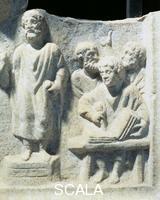Recent days saw a great number of reports, analyses, and comments on the death of Stefan Grimm, late professor of toxicology at Imperial College, London.
Several of these items contained copies of emails that (allegedly) were sent in the context and in the wake of this incident.
Among the most moving pieces in that regard was an an email that appears to have been sent by Prof. Grimm himself, offering his terrifying (yet not altogether inaccurate) insights into the perversions, excesses, and manifestations of anti-intellectual squalor in 21st-century British academia.
The story resonated with me, and I know for a fact that it resonated with many of my academic colleagues and friends as well, who have had similar (if usually rather less drastic or far-reaching) experiences.
Yet, whenever one seems to encounter a particularly compelling story, it is wise to be on the look-out for inconsistencies – and for what remains unsaid.
Quite apart from the fact that Prof. Grimm’s interlocutors, too, deserve to be heard (audiatur et altera pars – whether one appreciates their attitude or not!), and with all due respect to those who are still in pain and mourning over a personal loss: I cannot shake the feeling that we are missing something important here.
For one, we do not actually know what (or who) made Prof. Grimm kill himself.
A ruthless, cynical system? Bullying?
Possible.
But was it that alone?
We do not know. We cannot know.
What we see unfolding in front of our eyes, is the creation of a plot, the interpretative narrativisation of a string of events – compelling to many, as it contains so many familiar experiences.
But do we, the public, actually know anything about what was on Prof. Grimm’s mind?
I don’t.
All that I seem to know is that, with perfect dramatic timing, after about three months, all of a sudden, emails have come to light that offer a story that, for endemic reasons, most academics in British universities can easily relate to (not least in pre-REF-results-weariness).
Coincidence?
Whatever the case may be, one cannot deny a certain desire of one or more parties involved in this unsavoury, deeply saddening story to transform the actual goings-on into a dramatic, well-timed and well-planned performance: a performance, in which certain motivations behind Prof. Grimm’s ‘leaving the stage’ get stressed, while other factors that may have contributed to his decision to end his own life, would seem to remain in the dark.
The combination of the suicide motive with theatrical mise-en-scène has long fascinated me.
Only just recently, for my project on the Latin verse inscriptions, I had the (admittedly somewhat morbid) pleasure to re-read a fascinating text that reports a strikingly similar (and similarly striking) story.
Yet at the same time it is rather more outspoken about the stagecraft and poetic artifice behind the suicide (and the way in which it is told), and it made me wonder if there is a lesson to be learnt in this.
Latin documentary evidence for suicides is extremely scarce.
An inscribed sepulchral stele from Aeclanum (near modern-day Mirabella Eclano), dating to the Hadrianic period, is one of the very few surviving documents that explicitly report a voluntary death.
Framed between (i) a prose praescriptum (lines 1–4), dedicating the monument to the divine Manes and giving the deceased’s nomenclature, and (ii) a short prose postscriptum (line 20), containing a reference to the deceased’s wife, the central part of the inscription is made up of a poem (lines 5–19).
This poem is written in fifteen iambic senarii, a common rhythm in the Latin verse inscriptions (and in Roman drama!).
The inscription, as presented in the central area of the stele, reads as follows (CIL IX 1164 = ILS 2953 = CLE 97; for a more recent, emended edition see Mika Kajava and Heikki Solin [no. 15]):
D(is) M(anibus) [s(acrum)].
M(arco) Pomponio M(arci) fil(io) M(arci) n(epoti) M(arci) pron(epoti)
M(arci) abn(epoti) Cor(nelia) Bassulo
IIvir(o) q(uin)q(uennali).
ne more pecoris otio transfungere[r] 5
Menandri paucas vorti scitas fabulas
et ipsus etiam sedulo finxi novas,
id quale qualest chartis mandatum diu.
verum vexatus animi curis anxiis,
nonnullis etiam corpor[is dol]oribus, 10
utrumque ut esset taediosu[m ultr]a modum,
optatam mortem sum pot[itus quae] mihi
suo de more cuncta dat l[ev]amina.
vos in sepulchro hoc elo[gium in]cidite
quod sit docimento post m[eis gentil]ibus 15
inmodice ne quis vitae sco[pulos hor]reat
cum sit paratus portus [navigant]ibus
qui nos excipiat ad quiet[em perpet]em.
set iam valete donec vi[ta aequist pr]eti.
Cant(ria) Long(ina) marit(o) opt(imo) b(ene) m(erenti) f(ecit). 20
(1–4) Sacred to the divine Manes. For Marcus Pomponius Bassulus, son of Marcus, grandson of Marcus, great-grandson of Marcus, great-great-grandson of Marcus, of the Cornelian tribe, duumvir quinquennalis.
(5–8) Lest I misspend life, like cattle, in idleness, I translated a few well-known plays of Menander, and I even, with some industry, created new ones, such, whatever its quality, was committed to paper a long time ago.
(9–13) But tortured by anxious sorrows in my heart, and even some bodily pains, so that both had become a tedious burden beyond measure, I grasped death that I desired, giving me, in its own manner, relief from everything.
(14–18) You have this text inscribed on my tomb, so that it may serve my relatives as evidence, lest anyone be afraid beyond measure of life’s cliffs, when there is a harbour ready for those who navigate the sea, to welcome us to everlasting tranquillity.
(19) But now farewell for as long as there is a life (for you) that comes at a fair cost.
(20) Cantria Longina had this made for her husband, who was the best and most deserving.
The centre piece of this inscription, the poem, purports to be a tantamout to a suicide note – partly inscribed, no doubt, to tell a story, but also to offer advice: there is always an exit available to everyone, an exit to everlasting tranquillity.
The poem is carefully composed. There are three segments of comparable length that constitute the poem’s main part:
- Bassulus as a dramatic poet (4 lines, ll. 5–8)
- Bassulus’ suicide (5 lines, ll. 9–13)
- Bassulus’ advice (5 lines, ll. 14–18)
This is concluded by a one-liner, saying farewell (or rather: ‘so long’) to the living.
In its straightforward three-act design, the poem culminates in a story of mental and physical anguish of a man (of unknown age) who is presented as conceiving himself as an (either humble or depressed-sounding) playwright – a playwright who even in his epitaph casts doubt (in what may well be more than just the accustomed gesture of humility) on his achievements, both in terms of quantity and quality.
In true Sallustian manner, Pomponius Bassulus is shown as suggesting that his industry was a mere attempt to distinguish himself from dumb, idling beasts. A nice touch, to be sure, yet one cannot help but note that Pomponius Bassulus’ humble reference to his career as a playwright (and translator of Menander) is at contrast with the prose praescriptum. The inscription’s opening does not only trace his lineage back over four generations (demonstrating a surprising lack of imagination with regard to the finding of first names, even by Roman standards), but also suggests that he had successfully embarked on a career in local politics.
Returning to the histrionics of the epitaph, the dramatic bearing takes a turn for the tragic around the exact centre of the poem – in fact, line 8 of the poem (= line 12 of the inscription) is the one that mentions Bassulus’ success in seeking relief to his pains through suicide.
It is in this context in which we get to hear, however staged by a dramatic poet (if we are to believe that Bassulus wrote this poem himself), of the complexity of the deceased’s sorrows: mental anguish, physical pains, and both more painful (taediosum – a key term hinting towards suicide in ancient Latin inscriptions) beyond what one might bear (ultra modum).
Modus, measure, in taedium remains a key motive: Bassulus does not propose an easy way out: much rather, he says that there is no need to be afraid in life beyond measure (immodice) – a route not to be taken for as long as life comes at a fair cost, donec vi[ta aequist pr]eti.
Prof. Grimm, like Bassulus someone who could boast of his publication record, appears to have felt that his life no longer came at a fair cost – for whatever reason(s), and possibly even quite literally, if there is any truth to the horrendous details that have emerged from his academic life at Imperial College.
Yet, like Bassulus, he also appears to have taken the step to leave a written text as his legacy, giving a distressing outline of (some of) the cliffs that he was trying to circumnavigate in his professional life.
One wonders how Imperial College (as a mere placeholder for many an academic institution in 21st-century Britain) calculates the fair cost of life these days.

































You must be logged in to post a comment.